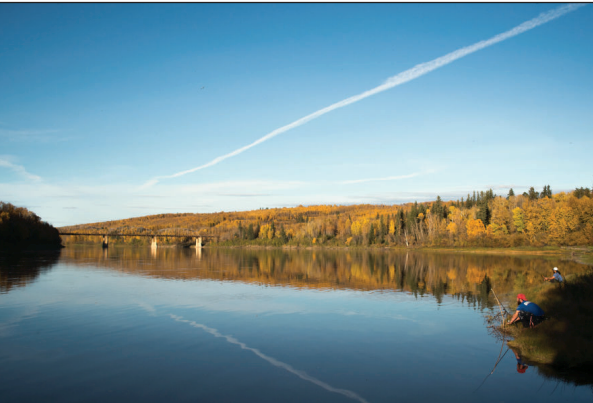Reduced flows from the Athabasca River are contributing to environmental deterioration at Wood Buffalo National Park, according to a new comprehensive report from Parks Canada.
The report was created by the firm Independent Environmental Consultants. It amasses studies and testimony on Wood Buffalo National Park, as well as the Peace-Athabasca Delta (PAD). The report recommends action be taken to prevent environmental degradation at the park, which is a world heritage site.
Keepers of the Athabasca is an Indigenous-led environmental advocacy group dedicated to the Athabasca River Watershed. Executive director Jule Asterisk said she is happy to see the attention the park is receiving.
"There's so many issues for Wood Buffalo National Park. I'm just glad it's got the attention of not just those closest to the land who've always had their attention on it, but also at a national, provincial and even international level," Asterisk said.
Many parts of the report highlight changes to the Athabasca River over the decades, noting its reduced flow levels have contributed to the reduced water levels of the PAD and Wood Buffalo National Park. It has declined 26 per cent from 1958 to 2007, according to the report.
"Seasonal flows in the Athabasca River have declined over the past 50 years due to a combination of increased water withdrawals and (past) climate change," the report said. "Flow rates changes on the Peace (River) and reduced seasonal flows on the Athabasca (River), in conjunction with climate change, have decreased water levels and the extent of open water in the PAD."
The report also notes Indigenous land-users in the PAD have found considerable changes in the quality of surface water over the past five or six decades.
"Many land users who used to dip a cup into the water and drink it now refuse to," the report said. "In addition, land-users are concerned about contamination that may be coming down the rivers from municipal, agricultural and industrial development."
Studies of the Athabasca River have said its reduced water flows are a result of water withdrawals, climate change, or a combination of both, according to the report.
"The overall effect of human activity, such as Peace River regulation, Athabasca River withdrawals, and climate change, influences valued components of the PAD ... including Athabasca River flows and water quality," the report said in its conclusions.
Industrial impact
Although the report notes issues with the Athabasca River, it said researchers have not necessarily attributed causes with certainty.
"While changes to water quality have been seen in the Athabasca River over time, it appears researchers cannot clearly attribute those changes to specific types of development," the report said, noting studies have suggested a variety of possibilities to changes in the river, including oil sands development, pulp mills and municipal wastewater treatment plants.
Asterisk said more research needs to be done to understand how industrial projects are impacting the health of the Athabasca River. She added the cumulative effects of these projects need to be considered as well.
"It boils down to the Indigenous philosophy and understanding that anything we do to the land and water, we do to ourself," Asterisk said. "When we don't have good control of mega projects, when we continually deny their cumulative affects, we're not just damaging the land and water, we're damaging our own selves."
The Athabasca River has also seen multiple spills over the years.
Prairie Mines and Royalty ULC was sentenced to a $4.4 million fine in 2017 for the 2013 Obed Mountain spill that led to 670 million litres of contaminated wastewater being dumped into the Athabasca River near Hinton. A University of Alberta study found the plume impacted water quality as it moved down river and demonstrated the potential for both direct and indirect impact to aquatic life.
Coal mining company Sherritt International Corporation was fined $1 million Oct. 3, 2017 after dumping an estimated 500,000 litres of effluent into the Athabasca River across three separate spills July 27, 2011 and August 2012.
More recently, the Town of Athabasca spilled approximately 1,000 gallons of grey water March 6 on the shores and ice surface of the Athabasca River due to a line failure, resulting in an emergency alert. Town utility operator Terry Kozinski reported to council April 17 the area was cleaned up, with the town spending $40,000 to hire an environmental company to address the area.
Taking action
The Government of Canada is planning to develop an action plan to address Wood Buffalo National Park, with $27.5 million allotted to the plan and its early implementation.
"Work on the action plan is well underway and Indigenous groups in and around Wood Buffalo have been engaged," Parks Canada media relations officer Audrey Champagne said in an email. She added a draft version of the plan is expected for Fall 2018.
The United Nations Educational, Scientific and Cultural Organization (UNESCO) conducted a monitoring mission at Wood Buffalo National Park in 2016, following a petition by the Mikisew Cree First Nation submitted 2014 highlighting concerns about the deterioration of the park. The mission's report recommended multiple assessments to examine environmental and social impact issues at the park.
The Keepers of Athabasca also continues its own works to address the health of the Athabasca River and PAD, Asterisk said. The group is planning a data visualization tool to highlight the effects of oil sands tailings ponds along the river. The group is also objecting to a proposed $20.6 billion oil sands mine from Teck Resources Ltd., south of Wood Buffalo National Park's southern border, between Fort McMurray and Fort Chipewyan.
Asterisk said she hopes the report on the park is a chance to highlight the damage humans are causing in the region.
"I just hope this is an opportunity to show some of the damages that we are currently incurring. Not just to the environment and to the land and water but also to human beings," she said.



